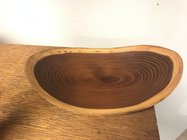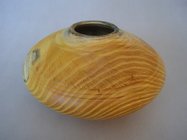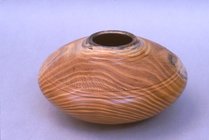I’m posting this under “Getting Started” because, though I’ve been turning for a while, it feels like a beginner question. I’ve been fortunate lately to have more wood than I know what to do with. We have a neighborhood listserv where I’ve posted that I’m interested in wood from arborist work, etc., and lots of folks have responded. My sense is that during Covid, many folks are spending money on tree work that they’ve been delaying getting to. (A nice side benefit of this is that I’ve gotten lots of bowl customers through my workshop.). My usual practice is to quickly cut blanks, bandsaw them round, put them in plastic bags, and then within a few days rough turn the blanks to bowls. Only then, coat the end grain with sealer and put them on the shelf or in one of two cardboard barrels to dry. My shelves and barrels are full, and I just yesterday processed about ten more sections of logs into 20 slabs of Osage orange and ash. Some are hopeful natural edge bowls and the rest traditional bowls. I won’t have time in the next few days to do any more with them. Is it safe to leave these slabs, untreated, in plastic bags? Should I seal the ends first? I’m hoping to be able to get to them by mid-next week. Just curious about how folks have the most success in avoiding checks on fresh-cut slabs. Thanks!
-
We just finished moving the forums to a new hosting server. It looks like everything is functioning correctly but if you find a problem please report it in the Forum Technical Support Forum (click here) or email us at forum_moderator AT aawforum.org. Thanks! -
Beware of Counterfeit Woodturning Tools (click here for details) -
Johnathan Silwones is starting a new AAW chapter, Southern Alleghenies Woodturners, in Johnstown, PA. (click here for details) -
Congratulations to Dave Roberts for "2 Hats" being selected as Turning of the Week for April 22, 2024 (click here for details) -
Welcome new registering member. Your username must be your real First and Last name (for example: John Doe). "Screen names" and "handles" are not allowed and your registration will be deleted if you don't use your real name. Also, do not use all caps nor all lower case.
You are using an out of date browser. It may not display this or other websites correctly.
You should upgrade or use an alternative browser.
You should upgrade or use an alternative browser.
Preferred wood storage method
- Thread starter Lou Jacobs
- Start date
Yes the slabs will be ok in a plastic bag for a week, especially if cold (mold usually not a problem in a week but if cold even less of a chance). The “most success” would be to also seal the ends, but IMO not needed for a week or 2 storage in bags.
I leave logs/sections whole with ends sealed, and cut them up as I get to them. This results in several blanks, which I keep in plastic bags until I get to them. I do mostly 1 turn items, and I dont like to precut blanks - Once cut the decision of what the piece will be has been made. Yes the ends do check, which is why the log sections are cut ~ 1-1/2 times dia (smaller logs left much longer, depends on the dia, ie weight of log) to leave room for cutting the ends off. I have a patio under my rear deck, out of the sun, off the concrete, where I store the logs, uncovered.
I leave logs/sections whole with ends sealed, and cut them up as I get to them. This results in several blanks, which I keep in plastic bags until I get to them. I do mostly 1 turn items, and I dont like to precut blanks - Once cut the decision of what the piece will be has been made. Yes the ends do check, which is why the log sections are cut ~ 1-1/2 times dia (smaller logs left much longer, depends on the dia, ie weight of log) to leave room for cutting the ends off. I have a patio under my rear deck, out of the sun, off the concrete, where I store the logs, uncovered.
- Joined
- Apr 27, 2004
- Messages
- 8,642
- Likes
- 4,982
- Location
- Lakeland, Florida
- Website
- www.hockenberywoodturning.com
Lived in md for many years.
If it is cold the bag life can be longer.
The plastic bags will prevent cracking for a long time.
Mold will grow within days with warmth
Color begins to deteriorate in about a week - you will lose the white in the Osage sap ring.
Some woods will rot within a couple months Osage is rot resistant
Osage makes wonderful NE bowls
It’s more work but I often remove the bark this make the bowl functional and the the white sap ring is a nice feature.
Below are a few Osage pieces with the sapwood. Bowl is about as dark as the wood gets. Two HF picks show the color change in progress. It will get as darker. The sapwood was near the end of its “use by” date



If it is cold the bag life can be longer.
The plastic bags will prevent cracking for a long time.
Mold will grow within days with warmth
Color begins to deteriorate in about a week - you will lose the white in the Osage sap ring.
Some woods will rot within a couple months Osage is rot resistant
Osage makes wonderful NE bowls
It’s more work but I often remove the bark this make the bowl functional and the the white sap ring is a nice feature.
Below are a few Osage pieces with the sapwood. Bowl is about as dark as the wood gets. Two HF picks show the color change in progress. It will get as darker. The sapwood was near the end of its “use by” date



Last edited:
I came into a maple tree last year and did 2 different things to see which would be the best for me. I split all the wood to remove the pith as much as possible. I then covered the ends with yellow glue and placed in my wood-shed. A month back, I moved some of these into my garage/shop awaiting lathe time. None of these have cracked so the glue worked great. The ones stored in the shed are out of sunlight and wind, the wood is one year old (cut). Shortly after treating all the wood this way, I went ahead and turned about 30 round blanks and put them in a chest freezer where they stayed until yesterday. During this time, none of the grain ends were treated. Pulling them out, I only lost 2 to cracking, the rest looked as good as the day put in freezer. I pulled one out this past summer and turned it. Turned good but the shavings felt like little pieces of sharp ice. Another one pulled to turn I let sit in the shop over night to thaw. It did not crack while thawing and turned easily but I bet thawing for much longer, it would have.
I have some red oak, box-elder, ash and elm. They have been drying about 1.5 yrs. The early pieces I did not seal have all cracked. The pieces I sealed with latex paint, all cracked. The only ones to have survived are the ones I started sealing with yellow glue and so far, they still do not have any cracks. I also have 8 blanks of walnut cut on my band-saw, sitting in my shop. These I coated heavily all way around with yellow glue to prevent cracking and so far..... knock on wood.... LOL
Another thought, I have several *exotic* blanks, all sealed in wax. Some of these I've had a couple years, none have cracked.
Good luck with yours!
I have some red oak, box-elder, ash and elm. They have been drying about 1.5 yrs. The early pieces I did not seal have all cracked. The pieces I sealed with latex paint, all cracked. The only ones to have survived are the ones I started sealing with yellow glue and so far, they still do not have any cracks. I also have 8 blanks of walnut cut on my band-saw, sitting in my shop. These I coated heavily all way around with yellow glue to prevent cracking and so far..... knock on wood.... LOL
Another thought, I have several *exotic* blanks, all sealed in wax. Some of these I've had a couple years, none have cracked.
Good luck with yours!
Last edited:
I leave logs whole. I have a storage area under a big Western Red Cedar, so no direct sun. I have a heavy vynal tarp on the ground, and over the top, and weigh down the sides, so pretty much totally covered. Don't bother to seal the ends. Earliest efforts did involve cutting the logs into sections and sealing them, but there always was cracking anyway, so I let them do their thing. Just about every log will have at least one crack off of the pith, and when I prep bowl blanks, That crack is where I cut down the center of the log. If I cut a bunch of rounds and won't get to them for a week or month or three, I will use the stretch film around them to seal the end grain. I have put them in plastic bags some times as well. Oh, maple will mold under plastic. I have noticed that the maple trees tend to lose their 'shine' very quickly, more so than most other woods. I am guessing that is due to the sugar in the wood and all the things that like to turn good wood into compost love the sugar.
robo hippy
robo hippy
Thank you all for this advice. Very much appreciated! I’ll go back this weekend to get more Osage, (She’s told me to take all I want) and won’t bother working on it now. I’ll look for log lengths 1 1/2 x the diameter, and just seal the ends, and see how they’ve fared when I’m ready to get to them. Now I just need to figure out where to store it all…
Angelo
President Emeritus
- Joined
- Jun 14, 2004
- Messages
- 399
- Likes
- 153
- Location
- Lancaster, Pennsylvania
- Website
- www.majicbrand.com
You can extend to storage life by spraying the wood with mildecide. It is ordinarily made for latex paint .Yes the slabs will be ok in a plastic bag for a week, especially if cold (mold usually not a problem in a week but if cold even less of a chance). The “most success” would be to also seal the ends, but IMO not needed for a week or 2 storage in bags.
I leave logs/sections whole with ends sealed, and cut them up as I get to them. This results in several blanks, which I keep in plastic bags until I get to them. I do mostly 1 turn items, and I dont like to precut blanks - Once cut the decision of what the piece will be has been made. Yes the ends do check, which is why the log sections are cut ~ 1-1/2 times dia (smaller logs left much longer, depends on the dia, ie weight of log) to leave room for cutting the ends off. I have a patio under my rear deck, out of the sun, off the concrete, where I store the logs, uncovered.
